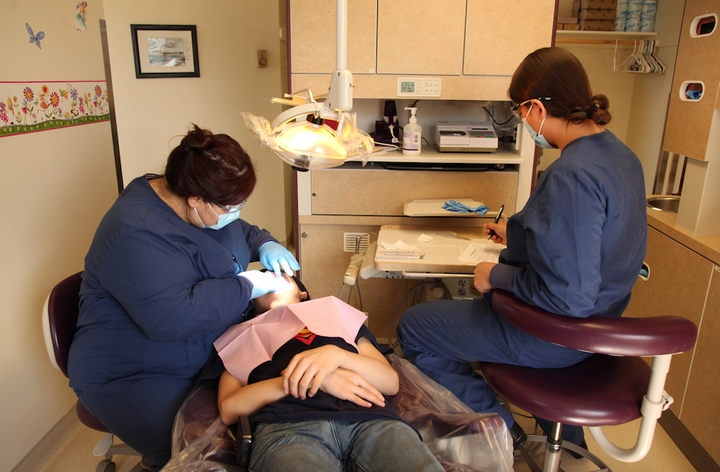
Dental Therapists, Elsie Pelawook and Savannah Bonorden, performing dental work on a patient.
One of the most prevalent talking points used by an entrenched special interest to keep a new clinical profession from flourishing in the United States has been shown to be unfounded: The use of mid-level providers in dentistry can make a big difference in the oral health of people who live in communities where dentists are few and far between.
A recently completed study by researchers at the University of Washington shows that children and adults in Alaska Native communities served by dental therapists—comparable to a nurse practitioner or physician assistant— had significantly better oral health outcomes than people in communities not served by them.
Why does this matter? The current dental delivery system isn’t meeting the needs of many people in this country. A third of Americans have no dental coverage, a big reason why Americans pay 40 percent of dental care out of pocket, according to a recent analysis. That compares to 11 percent of expenses for other types of health care. The analysis, conducted by the American Dental Association, noted that even people with dental insurance struggle to pay for dental care.
Despite this, the ADA and affiliated state dental societies have tried to block efforts to allow dental therapists to practice in the United States. They’ve questioned the role dental therapists can play in improving access and outcomes and have raised unsubstantiated safety and quality issues.
The new University of Washington study is the first to look at long-term outcomes of U.S. communities served by dental therapists, who work under the supervision of a dentist and whose scope of practice ranges from preventive care to fillings and uncomplicated extractions.
The study found that children with the most exposure to dental therapists had more preventive visits and fewer extractions. They also had less exposure to general anesthesia during procedures. Adults in communities with the highest use of dental therapists also had more preventive visits and fewer extractions.
“We found positive associations between dental therapist treatment days and preventive care outcomes, as well as extraction outcomes,” said lead researcher Donald Chi, DDS, PhD.
“What that means is that across the communities, generally the more dental therapists were providing care in communities, the more preventive care individuals got, and the fewer extractions patients were getting. Collectively, what that tells me is that over the ten-year time period (of the study), dental therapists were having an impact. They were making a difference in terms of preventive care and people keeping more of their teeth.”
The study covered ten years, from 2006, the first full year the Alaska Native tribes employed dental therapists, through 2015. Researchers used patient records and Medicaid claims data to determine what impact, if any, dental therapists have had on the oral health of residents of several Alaska Native tribes in a region the size of Oregon. Several of those tribes were served by a dental therapist while others were not or at least not as frequently.
Alaska Native tribes pioneered the use of dental therapists in the United States asserting sovereign authority to employ them. Tribes in other states have since followed suit or are considering it. In recent years, dental therapists have been authorized to practice statewide in Minnesota, Maine and Vermont. They are now also treating patients in Native American tribes in Washington and Oregon. Several other states, including Arizona, Kansas, Maryland, Massachusetts, Michigan, New Mexico, North Dakota and Ohio are now looking at expanding the dental team to include dental therapists.
Chi and his fellow researchers have now begun a separate, qualitative study on the impact of dental therapists.
“We've looked at data that already exists to crunch the numbers to see quantitatively what these differences are,” he said. “Now, the next part of our study, we'll go into half a dozen communities to talk to parents as well as individuals who have been served, who have received care from dental therapists, to systematically collect their stories and narratives about their experiences with dental therapists.”
Chi noted that while the research is focused on communities in Alaska, dental therapists could produce similar outcomes throughout the United States. There is growing evidence they already are. In Minnesota, 70 dental therapists are serving primarily low-income patients in both rural and urban areas of the state.
And in just one year of practice, a dental therapist at the tribal-operated Swinomish dental clinic in northwest Washington state treated more than 700 patients. In 2015, the year before he started seeing patients, patients waited from three to four months for an appointment. The wait time is now three to four weeks. His addition to the dental team enabled the clinic to see 20 percent more patients in 2016 than the year before.
“There are lots of communities in the lower 48 (where people) have major problems with their teeth and with their mouths,” said Chi. “I think our findings in Alaska are applicable to any community where there are groups of individuals who are underserved and in need of dental care.”
The University of Washington study was funded by The Pew Charitable Trust, the Rasmuson Foundation and the W.K. Kellogg Foundation. A previous study conducted in 2010 by researchers at RTI International, found that the ADA’s questions about the safety of care provided by dental therapists were not supported by data. The RTI researchers found that dental therapists improve access to care, specifically for children, are effective in providing oral health care within their scope of practice, have a record of providing oral health care safely and can decrease the cost of care.
